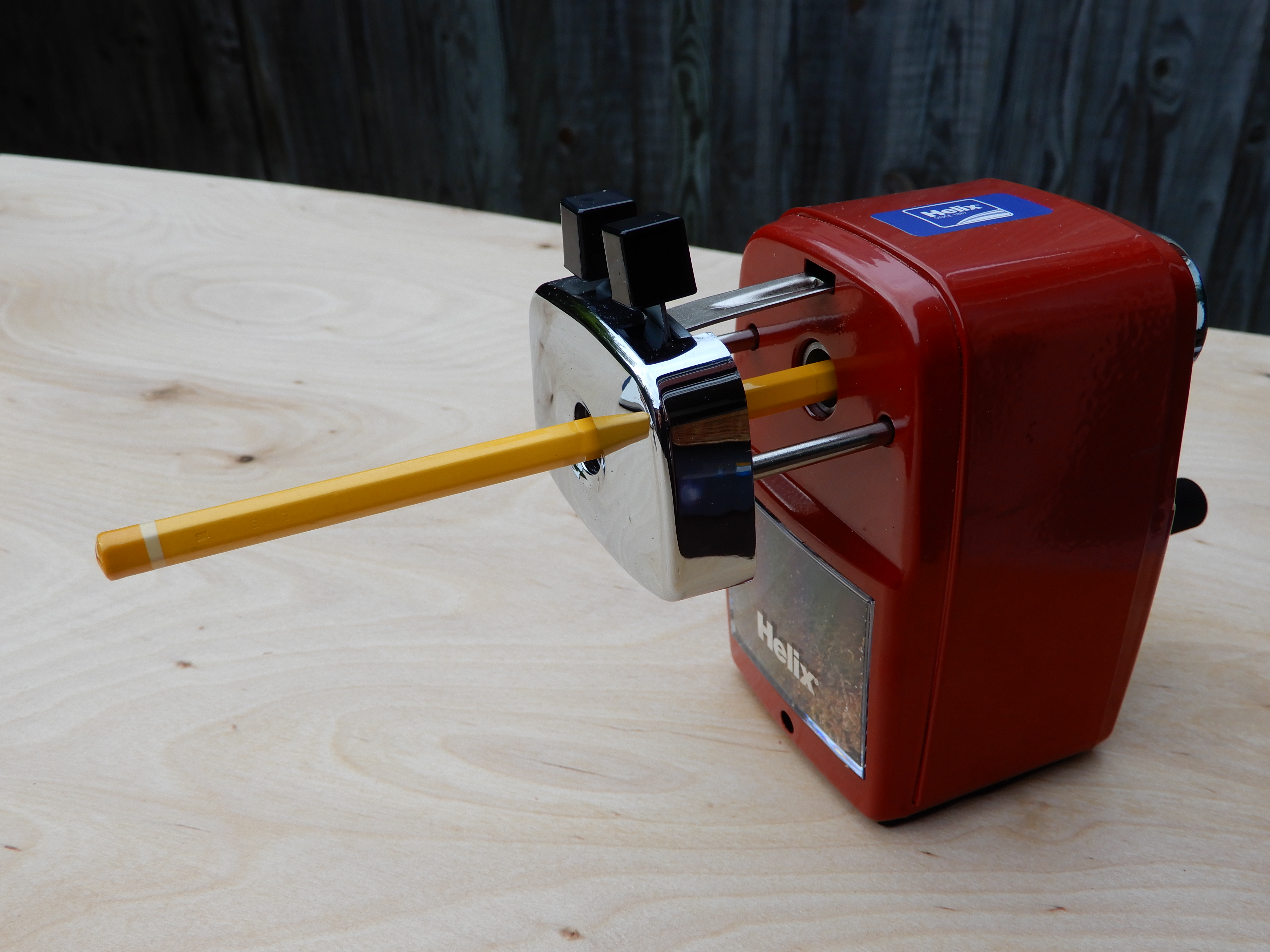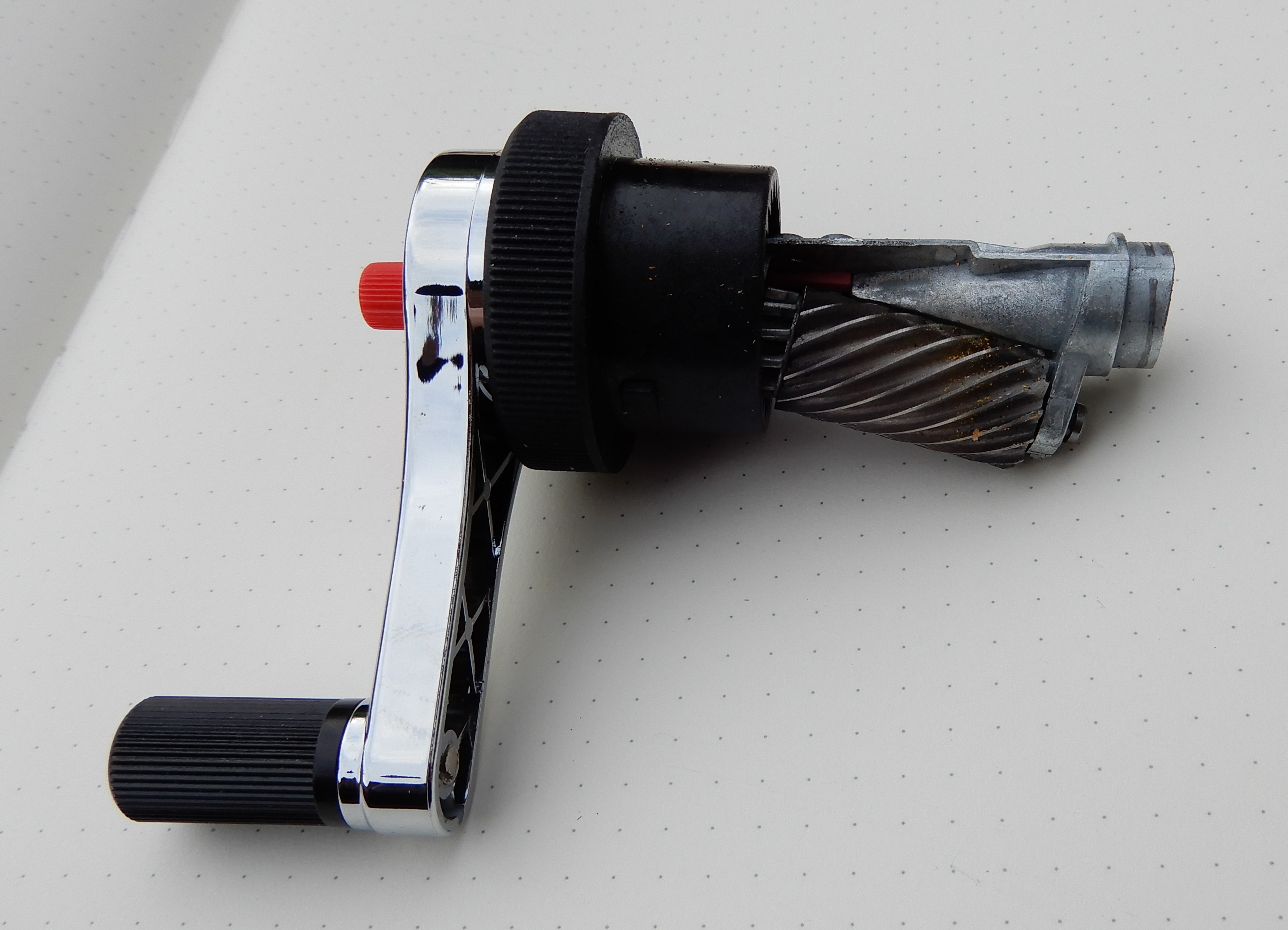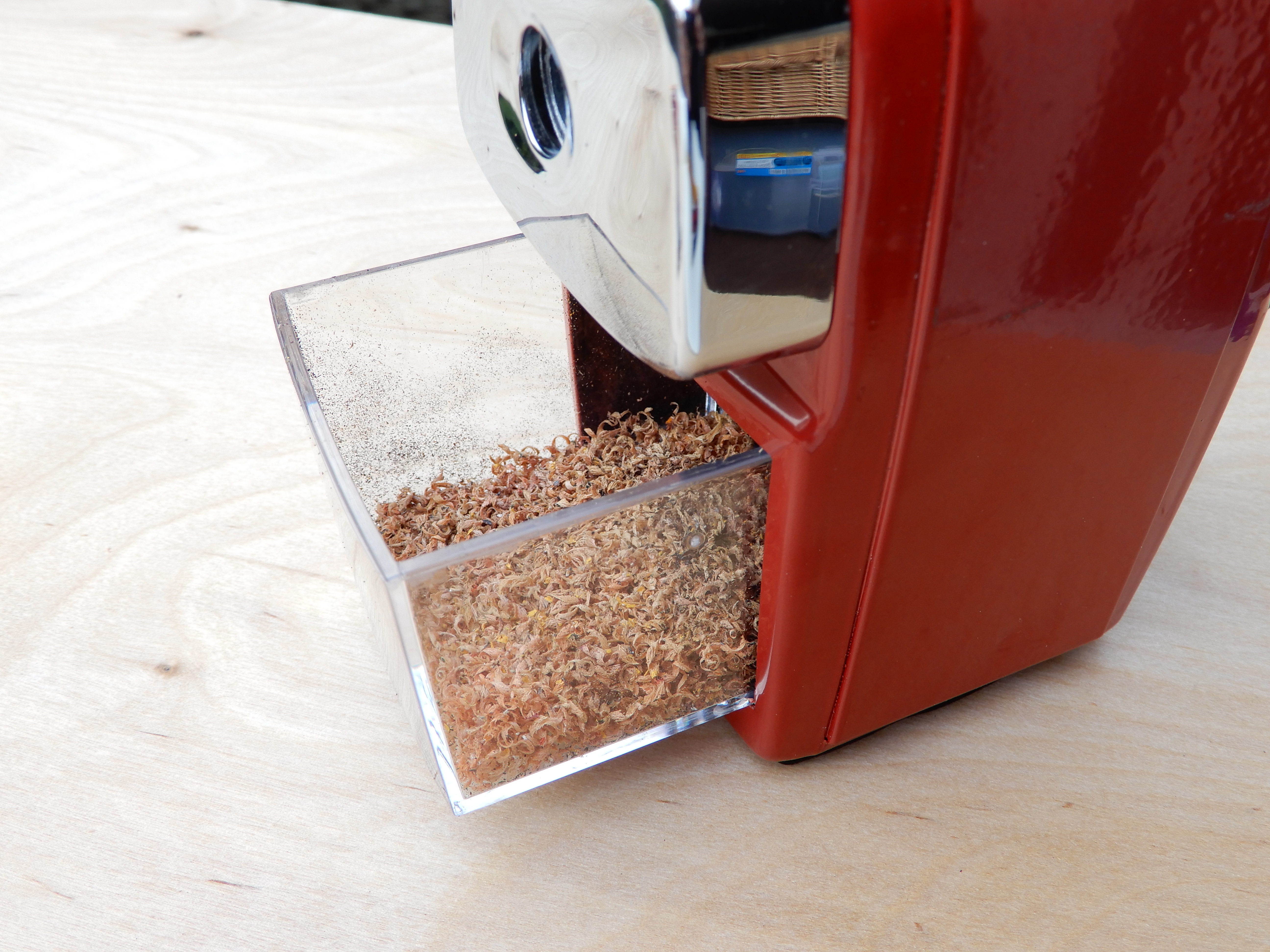I first spotted this for sale, in a rather battered cardboard box, at our local Ryman stationer a few of weeks ago. I did not buy it the first time, but when I saw it still sitting there last weekend, I decided that it needed a new home.
It is an intriguing device. Ryman has a selection of pencil sharpeners, including battery operated models but it was this good old fashioned hand-wound model that appealed to me. Perhaps it was a reminder of primary school days when the teacher had a pencil sharpener clamped to the edge of the desk.

According to the box, there are three colour options, blue, black and red. There was only this one on the shelf, which was red and that seems a good colour for a pencil sharpener.
I stood for a while in the shop, looking at the instructions and features and trying to visualise how it all worked. When I came to buy, I was given 10% off for the damaged box which brought the price down from £14.99 to £13.49, an unexpected bonus. (Note: they are currently for sale on Ryman online, at £14.99 and part of their 3 for 2 promotion).

This is my first experience of owning a desk top sharpener. Its features include five settings for various grades of sharpness; a quick release to clear broken leads; a clear plastic tray to collect the shavings; an anti-slip base and a simple clamp for easy attachment to a desk. It is not essential to clamp it and you can still operate it by pressing it down with one hand, whilst operating the crank with the other. You do not need to hold the pencil.
The two cute little ears on the front are actually to squeeze and open a grip, to hold the pencil.
It is very exciting to sharpen your first pencil. The procedure is as follows:
- Select your desired setting. The first on the left is the sharpest;
- Pull the chrome “carriage” forward, against the tension of the spring inside, until it locks into position;
- Squeeze the two black levers, opening the sprung aperture, or “jaws” which grip the pencil; insert a pencil, as far as it will go into the sharpening chamber, then release the black levers;
- Holding the sharpener down firmly (if not clamped), wind the crank clockwise for a few turns until you feel no resistance and it turns freely; once sharp, the handle continues to rotate but the pencil will stop being sharpened;
- Squeeze the levers, and remove your now sharp pencil.

I rounded up about 35 pencils from the house and gathered them together to be sharpened. This was an interesting diversion in itself as I recognised a few pencils from years back which brought back different memories.
I found some 2B and 3B pencils, that I had used for drawing, decades ago. Also there was a pencil in white with the red lettering of Greater London Record Office and their old style central London telephone number. I had been given this when visiting the offices near Farringdon to research a property title, looking at records on microfiche, some time in the 1990’s. It was forbidden to take notes in anything but pencil for fear of damaging the aging records.

I was interested to try the five different point settings. To adjust the setting, you turn a red plastic selector. I found that I had five Staedtler Noris HB pencils and so tried sharpening one each at the five different settings to compare the results.

Having figured out how to operate it, I tried removing the handle and the blade. These are easily removed by turning the black locking ring 90 degrees anti-clockise and then pulling it out carefully through the hole. The instructions warn against holding the blade, which is obviously sharp. It should be gripped in a vice if unscrewing the handle.
I found it quite fascinating to see how it works. With a pencil inserted, the pencil is gripped and does not rotate, but just pulled forwards. Instead, the conical sharpening chamber rotates around the pencil. A cylindrical blade, rather like a lawn-mower blade with a sharp edged, helical arrangement, rotates over a slot in the sharpening chamber. It is a joy to watch and an amazing design.

To replace the crank and sharpening assembly back into the device, (which is slightly more fiddly than taking it out), offer it up carefully back into the hole, then turn the black locking ring 90 degrees clockwise. I found that it helps to try to hold the crank and the locking ring tightly together as you do this.

To empty the shavings , the clear plastic drawer is just pushed out freely out the front. It will not go in too far or come out through the back.

As you can well imagine, I had a happy time sharpening a batch of pencils, whilst reminiscing over days of old and restoring lots of elderly stubs to a sharp condition once again. It makes for a pleasant afternoon and is a fine pursuit for National Stationery Week here. The sharpener is a marvel of design, works well, is good value and has a very refreshing old world charm.


I have fond memories of sharpeners like this from my elementary school days. A couple of years ago, I was fortunate to find one of the limited edition red sharpeners by Caran d’Ache. It functions much the same as the Helix, but is made entirely of metal, and is much heavier and sturdier. Those of us of a certain age will definitely enjoy sharpeners of this type.
LikeLiked by 2 people
That’s right. I have a new appreciation for these sharpeners and will be interested to see models from other brands but will try to avoid accumulating more of them.
LikeLike
Thanks for another great article. These kinds of sharpeners are fantastic analogue tools. I had no idea that these Helix models still existed. I have used similar designs from the likes of Caran d’Ache, Carl and Uni (Mitsubishi) but the colour of yours is far more attractive. There is something very satisfying about giving new life to old pencil stubs with a machine such as yours. By the way, you also have some great pencils in the photo! I really like the Berol Venus and the red Staedtler Noris (sixth from left).
LikeLike
Thank you very much for your comments. I am new to these sharpeners and have not tried any other brands yet but will look out for them with new interest. I need to take more notice of different types of wooden pencils too.
LikeLike
Another reader experiencing a twinge of school days nostalgia here. I’ve just discovered the long point sharpener and that seems technical enough for me!
LikeLiked by 2 people
That sounds interesting. Do you know the make and model?
LikeLiked by 1 person
Yes, it’s one of these – https://www.cultpens.com/i/q/KM08489/kum-automatic-long-point-sharpener-as2
From what I can tell, it seems to be more or less the same as the Blackwing version (https://www.londongraphics.co.uk/palomino-blackwing-long-point-sharpener) minus the branding and the huge mark-up! A friend has the Blackwing one and tells me the blades for his are made by KUM, which further suggests the tie-in. He was more than a little hacked off when I told him how much I paid for mine!
I’ve decided I quite like this long point malarkey…
LikeLiked by 2 people
Thank you for the info. I see what you mean. I might just have to include one of these in my next order from Cult Pens
LikeLiked by 1 person
All of our teachers had something like that on their desks. I also remember inserting just about anything I could lay my hands on into the desk sharpener whenever our teacher was out of the room or not looking. Paintbrush handles were sharpened (probably dangerous!)… the class hamster had some stick-like chews — they got sharpened (the hamster didn’t seem to care). Mrs. Jackson was always wondering why her sharpener never worked very well.
LikeLiked by 1 person
Happy memories! This device takes me back to the late sixties. I remember rainy days when outdoor playground time was cancelled and instead we had ‘wet play’, when the drawing paper and box of wax crayons came out!
LikeLiked by 1 person
We went to very similar schools 🙂
LikeLiked by 1 person
Nice! These sharpeners are clunky but amazing.
LikeLiked by 1 person
Exactly! It is leading me to rediscover the beauty of wood cased pencils. For a long time I had been using only mechanical ones.
LikeLiked by 1 person
I have had my Helix sharpener for about 7 years and it has been on regular use ever since. I have tried other makes of similar type sharpeners and this is the only one which doesn’t chew up and break the leads in my pastel pencils. However, the device is now due for a new replacement blade and I am unable to fine one. Does Helix do a replacement blade barrel or not ? If they are available, who is supplying them in the UK please? Thank you. DC
LikeLiked by 1 person
The Helix metal desktop sharpener is still available on Amazon at £10.99 and so you might as well replace the whole sharpener. I do not know whether you can buy replacement blades separately. You may try to contact the makers online.
LikeLike
Thank you for sharing this. Was having a hard time using the sharpener. Glad you took time to write this out. Blessings!
LikeLiked by 1 person
Thank you Moses. This was quite an old post but I still have the desktop pencil sharpener, although to be honest it is more of an ornament than a tool.
LikeLike